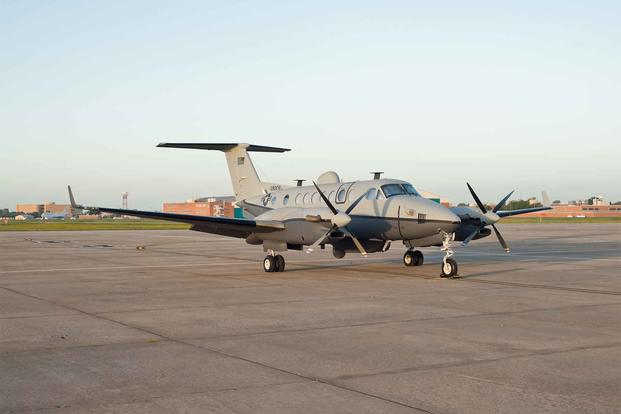The U.S. Air Force finds itself at a crossroads on what to do about its small aircraft fleets, which no longer fit within its budget strategy. It soon must look for new ways to combine or repurpose missions among these aircraft or get rid of them for good, according to a new report.
While introducing the Center for Strategic and International Studies' latest report, "The Air Force of the Future: A Comparison of Alternative Force Structures," Todd Harrison, director of the Aerospace Security Project for the think tank, explained that having limited numbers of certain aircraft is driving operational costs for the service at a time when it needs to be more conscious of where its money is going.
"The fiscal 2020 budget is the second highest request it's ever been in the history of the Air Force," Harrison told reporters earlier this week at CSIS. "But if you look at force structure and inventory of aircraft, it's actually at a near all-time low."
Harrison crunched the numbers and compared three recent congressionally mandated studies -- one each from the Air Force, the Center for Strategic and Budgetary Assessments and MITRE Corp. -- to produce his own report.
Related: The Air Force Is Ready to Scrap Older Aircraft to Prepare for Future Wars
The service in March requested $204.8 billion, including "non-blue" dollars, which fall under the Air Force but are not managed by the service. Of that, it would oversee $165.6 billion, a six percent increase from its fiscal 2019 request.
That would support "some 5,300 aircraft and 333,000 active-duty service members," Harrison said. By comparison, the service's request was at an all-time high in fiscal 1985 dollars -- the equivalent of $210 billion today -- but the Air Force had an inventory of more than 9,400 aircraft, according to provided statistics.
Harrison found that, because costs of operating, staffing and equipping the force have increased over time, the service has had to budget more money toward some efforts just to keep them going.
That includes small fleets of aircraft, such as intelligence-gathering planes like the MC-12 and U-28 Draco, as well as very specialized aircraft like the E-4B Nightwatch, E-8 Joint Surveillance Target Attack Radar System (JSTARS) and RC-135 reconnaissance aircraft, among others.
Though it's unlikely the service would pull the plug on using aircraft such as the E-4B -- the nuclear command-and control aircraft more commonly known as the "Doomsday" plane -- the problem "that the Air Force has right now, which is making its operating costs so much higher, is because they have so many small fleets," Harrison said.
"When you have a large fleet, the cost per plane goes down, [but] small fleets, the cost per plane goes way up because you have huge fixed costs with each of your aircraft types," he said.
It takes specialized equipment, maintenance and training to sustain them, taking airmen away from bigger missions, he explained.
Through the fiscal 2019 defense budget, the service officially put to bed the E-8C JSTARS recapitalization effort in favor of the Advanced Battle Management System. Capable of developing, detecting, locating and tracking moving targets on the ground, the E-8 will still fly into the mid-2020s.
But that's just one aircraft. The service may have to follow that same blueprint for other aircraft or come up with a strategy for planes take on roles they haven't had before, Harrison said.
Those decisions could benefit more than one military branch, he added.
"There are a number of aircraft that the Navy fields that are land-based, fixed-wing aircraft that are either commercial derivatives or derivative of Air Force platforms," he said. "And it makes you wonder why is the Navy keeping those roles and missions? Why hasn't the Air Force stepped up and said, 'You know what, I can do some of these things,'" or vice versa.
Harrison noted the Air Force has been particularly successful at using its unmanned fleet in place of other fighter or attack aircraft for surveillance and strike missions worldwide.
It costs much less to launch an MQ-9 Reaper -- at roughly $800 per flying hour -- to scope out a battlefield than a manned intelligence, surveillance and reconnaissance (ISR) platform, Harrison said.
"They are by far the cheapest aircraft in our inventory in terms of the reimbursement costs per flying hour. They're very inexpensive," he said.
"I think we also need a road map for [remotely piloted aircraft], in terms of, 'What are the new missions that we can start to transition over to RPAs?' And to find some new operational concepts for how we use them," he continued. "From a cost perspective and a readiness perspective ... the [Air Force] RPA fleet stands out from the rest of the Air Force because it costs a lot less to operate, and we utilize them much more. So we need to leverage that. That's a strength of the Air Force that we need to double down on."
-- Oriana Pawlyk can be reached at oriana.pawlyk@military.com. Follow her on Twitter at @Oriana0214.
Read more: Here's Video of the Special Operators Closing In on ISIS Leader Baghdadi's Compound














